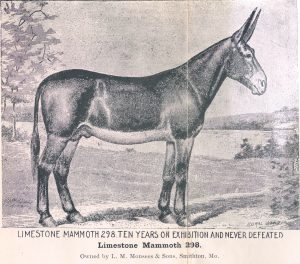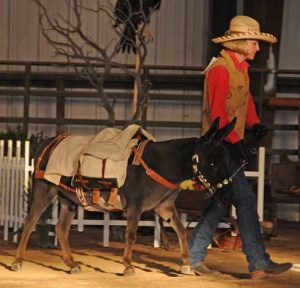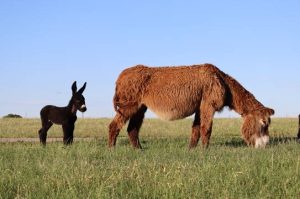by Leah Patton, American Donkey and Mule Society
Heritage Donkeys in American History
The donkey, often misunderstood and sometimes overlooked, is a close cousin of the horse and has played a significant role in the foundation of civilization for approximately 5,000 to 7,000 years. These remarkable animals have gained our affection through their companionship and assistance in overcoming various hardships throughout history.
Historical Significance
Originating in northern Africa and the Arabian Peninsula, donkeys of diverse sizes, shapes and colorations have assisted humans for
thousands of years. In the tombs of Pharaohs, stone carvings depict donkeys carrying goods and materials along the Nile River. They traversed trade routes across Asia and Europe, inspiring ancient art in China, illustrating players riding donkeys and mules to play polo. French tapestries from the 1500s showcase working mules and Poitou-type donkeys.
From Europe to the Americas
In the United States, a wide variety of donkey sizes and types serve as both working animals and companions. Most U.S. donkeys have European origins, including the Mexican Burro, introduced by Spanish explorers in the early 1500s. This breed, known for its “gray-dun” color and a cross over the shoulders and spine made its way into the American southwest by the early 1800s.
In the U.S., donkeys are typically categorized by type and height rather than by breed. Standard donkeys, often a mix of Mammoth, burro, and miniature bloodlines, come in various shapes and colors. They have played an essential part in our history and remain a significant part of the long-eared equine population in the U.S., with no immediate threat of extinction. However, three donkey breeds are listed as endangered heritage breeds on The Livestock Conservancy’s Conservation Priority List. They are the American Mammoth Jackstock, developed in the U.S., and two imported breeds, the Miniature and Poitou.
American Mammoth Jackstock
The American Mammoth Jackstock is the largest donkey breed, with jennets (females) at least 54 inches tall and jacks (males) at least 56 inches. In the 1780s, George Washington was given two large jacks from France and Spain. They were selectively bred with local mares to produce large working mules, crucial for agriculture. Developed from large Spanish Andalusian, Maltese, Catalonian, Majorcan and Poitou varieties, the Mammoth produced mules that plowed millions of acres across this country. Our ancestors found that mules could thrive in conditions where horses wouldn’t.
Typically, dark brown or black with light points, the American Mammoth Jackstock comes in a variety of colors, including spotted. They are lean-limbed and well-balanced, with large ears. There are two diverse types: a heavier, dappled Andalusian type, said to date to ancient times, and the taller, leaner Majorcan/Maltese type. Their numbers peaked around 1920 at approximately 5 million but declined sharply with industrialization in the early to mid-1900s. Although their numbers have since increased, this breed remains critically endangered.
Miniature
Originating over 2,000 years ago on the islands of Sicily and Sardinia, the Miniature donkey is now nearly extinct in its native land. First
imported to the U.S. in the early 1900s, a registry was established in 1958. Originally numbering approximately 100 donkeys, there are now over 75,000 Miniatures in the U.S. registry. These animals range from 25 to 36 inches tall at maturity, with both heavy drafty types (more like the original imports) and lighter, fine-boned individuals, in a wide range of colors.
Miniature donkeys are known for their affectionate and friendly nature. Although there is a cyclical interest in smaller animals, larger Miniatures are often preferred for driving, even for adults. They are wonderful for children wanting to show and are capable as small packing and hiking partners. Their continued popularity has kept them at the forefront of donkey ownership, with animals now being returned to European countries. The breed is classified in the Watch category on the Conservation Priority List because of their small global population.
Poitou
The Poitou donkey, an ancient breed originating in southern France, was mostly unknown outside its native region until recently. Historically, Poitou jacks, measuring 54 inches or taller, were used to produce large mules from the also-endangered Mulassier mare. In the early to mid-1900s, the rise of combustion engines and reduced need for horse and mule power nearly led to the extinction of both the Mulassier and the Poitou.
In the 1980s, a few Poitou donkeys were exported to the U.S. Over the past four decades, breeders, veterinarians and conservationists in the U.S. and France have worked collaboratively to increase this breed’s population, which has grown from four animals to over 150 in the U.S. today. The establishment of a new registry and breed association, alongside newly developed breeding and foaling protocols, has aided in the recovery of the Poitou, which, despite these efforts, remains critically endangered worldwide.
Poitou donkeys are all dark brown with a light nose and belly. Traditionally, the Poitou is characterized by a long-corded coat, which is believed to signify purity in the breed. Those who meet a Poitou almost instantly fall in love with their thick legs, wide hooves, huge shaggy ears and “stuffed plush animal” appearance. Gentle in nature, they are quick to steal hearts!
How You Can Help Donkeys
If you’re considering donkey ownership, it’s essential to choose the type and size that is right for you. Do you want to ride? Are you looking for a donkey suitable for children? Or are you interested in helping to increase a critically endangered population? To learn more about each heritage breed on The Livestock Conservancy’s Conservation Priority List, check out the information at https://livestockconservancy.org/heritage-breeds/conservation-priority-list/.
If you decide to purchase a donkey, you can locate heritage donkey owners and breeders in our online Breeders and Products Directory at https://livestockconservancy.org/heritage-breeds/breeders-directory/
Even if you don’t plan to own a donkey, you can support these breeds by raising awareness of them. Follow our Facebook page https://www.facebook.com/livestockconservancy and share our posts to spread the word about these and other valuable endangered heritage breeds.
If you would like to support the ongoing work of The Livestock Conservancy, you can learn about becoming a member or making a donation at https://livestockconservancy.org/
Join Us Next Month
We’ll share a new blog each month in the Celebrating 250 ongoing series. You can find past blogs in the series at this link: https://livestockconservancy.org/250
In October, we will explore the history of heritage goat breeds on The Livestock Conservancy’s Conservation Priority List.







